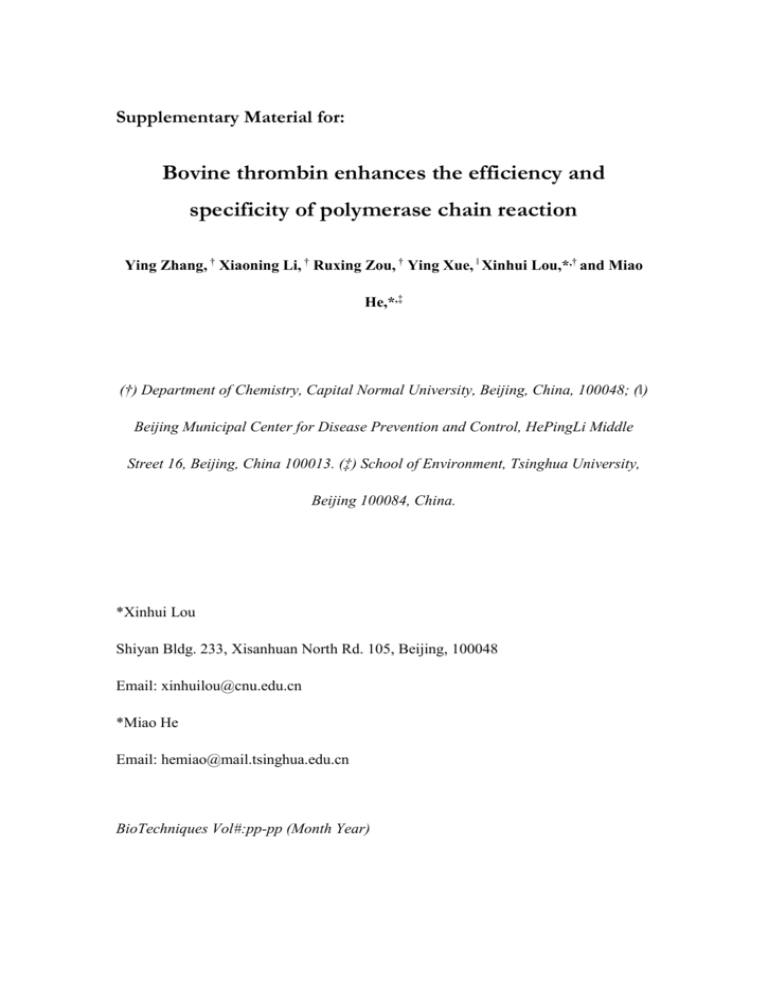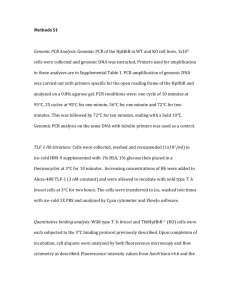Supplementary Material
advertisement

Supplementary Material for: Bovine thrombin enhances the efficiency and specificity of polymerase chain reaction Ying Zhang, † Xiaoning Li, † Ruxing Zou, † Ying Xue, ǁ Xinhui Lou,*,† and Miao He,*,‡ (†) Department of Chemistry, Capital Normal University, Beijing, China, 100048; (ǁ) Beijing Municipal Center for Disease Prevention and Control, HePingLi Middle Street 16, Beijing, China 100013. (‡) School of Environment, Tsinghua University, Beijing 100084, China. *Xinhui Lou Shiyan Bldg. 233, Xisanhuan North Rd. 105, Beijing, 100048 Email: xinhuilou@cnu.edu.cn *Miao He Email: hemiao@mail.tsinghua.edu.cn BioTechniques Vol#:pp-pp (Month Year) 1. Preparation of 13 nm AuNPs. A solution of 13 nm AuNPs was prepared by following previously published protocols. Briefly, an aqueous solution of HAuCl4 (1 mM, 250 mL) was heated and refluxed for 10 min. A solution of trisodium citrate (38.8 mM, 25 mL) was quickly added to the refluxed HAuCl4 solution, resulting in rapid color change from pale yellow to deep red. After continuous reflux for an additional 15 min, the solution was slowly cooled to room temperature and filtered through a 0.22 μm cellulose nitrate filter. The solution was stored at 4°C until needed. The quality of the particles was monitored using UV/Vis absorption spectroscopy and transmission electron microscopy (TEM). The size of the particles was 13 nm and the concentration of the solution was 12 ± 1 nM using UV/vis spectrophotometric measurements based on an extinction coefficient of ~2.7×108 M–1 cm–1 at 520 nm for 13 nm AuNPs. 2. PCR of human amelogenin gene. 2.1 The amelogenin genes. The amelogenin genes (AMEL X and AMEL Y) present on both the X and the Y chromosomes are routinely used for sex discrimination based on their size difference. There is a 90 bp deletion on X-Y homologous region of the AMEL X gene on human X chromosome. The DNA sequences were described in Figure S-1. Figure S-1. (A)The genomic sequences used for human gender determination. (B) A schematic drawing to illustrate the location of the 90 bp deletion. 2.2 PCR of the human amelogenin genes. The PCR amplifications were performed using Taq DNA polymerase from Promega. Two sets of reverse primers and forward primers with different length were used in the optimization of the PCR amplification (Table S-1) according to the sequence shown in Figure S-1. As shown in Figure S-1, the first set of primers with 24 bp (Table S-1, A)were shown in bold and the corresponding products of PCR for female sample should contain only the 79 bp fragment and for male sample should contain both 79 bp and 169 bp fragments. The other set of 28 bp primers (Table S-1, A) were also used for PCR optimization study. The binding specificities of the primers were confirmed using the BLAST program (http://www.ncbi.nl.nih.gov/blast/). PCR cycling conditions consisted of an initial 2-5 min preheating at 95 °C, followed by 30 amplification cycles of denaturation at 95 °C for 1 min, annealing at 50-56 °C for 30 s and extension at 72 °C for 20 s. Each PCR tube contains 80-1200 ng human genomic template, 30-50 pmol forward primer, 30-50 pmol reverse primer, 200 μM dNTPs, 1.5 mM MgCl2 and 2.5 U Taq DNA polymerase in a 100 μL 1 x PCR buffer. Under varied conditions as shown in Table S-1, B, primer-dimers existed all the time. Table S-1. (A)The sequences of the two sets of primers used in this study and (B) the varied conditions for PCR optimization and results. 3. Hepatitis B virus (HBV) DNA sample preparation. HBV genomic DNA was extracted from 100 μL of serum sample by using a QIAamp DNA Blood Mini kit. Centrifuged the samples at 4℃, 6000 rpm, 15 minutes twice, took the supernate carefully to get target HBV DNA samples. The target DNA was then amplified using the primers (HBV-FP and HBV-RP, Table 1) which were shown in bold in the following HBV DNA sequences. A 354-bp product was generated through PCR and the sequencing was performed by TaKaRa Biotechnology Inc. (Dalian, China). The sequences of the targets were listed here: 5’-TATGGGAGTGGGCCTCAGTCCGTTTCTCCTGGCTCAGTTTACTAGTGC CATTTGTTCAGTGGTTCGTAGGGCTTTCCCCCACTGTTTGGCTTTCAGTTAT A(G)TGGATGATGTGGTATTGGGGGCCAAGTCTGTACAACATCTTGAGTCC CTTTTTACCTCTATTACCAATTTTCTTTTGTCTTTGGGTATACATTTGAACC CTAATAAAACCAAACGTTGGGGCTACTCCCTTAACTTTATGGGATATGTA ATTGGAAGTTGGGGTACTTTACCGCAGGAACATATTGTACTAAAGCTCAA GCAATGTTTTCGAAAACTGCCTGTAAATAGACCTATTGATTGAAAAGTAC GATG-3’ There was one base difference between different samples, which was corresponding to the wild type gene (rtM204M) and its point mutated gene (rtM204V), respectively. Figure S-2. (A)The real-time PCR demonstrated that TB improved the efficiency of PCR for the low-copy synthetic pool (1.2×104 copies in 20 μL of PCR mixture). The reactions with and without TB were performed in triplicate and only one typical curve for each situation was shown. (B) Melting curves indicated the improved specificity of PCR at the presence of TB. The three melting curves for the sample containing TB are overlapped with each other and only one curve is shown for clarity. The experimental conditions were provided in the experimental section. Figure S-3. The ranges of working concentrations of BT to relieve the PCR amplification inhibition caused by gold nanoparticles (AuNPs) at 0.2, 0.5, 1.0, and 2.0 nM. M: 20 bp marker; 1: Blank; 2: male genomic DNA sample (172 ng); 3: male genomic DNA sample with AuNPs at varied concentrations; 4-7: 3 with BT at varied final concentrations (0.37, 3.7, 37, and 370 μg/mL). Figure S-4. The ranges of working concentrations of BT to relieve the PCR amplification inhibition caused by graphene oxide (GO) at 0.1, 0.5, 1.0, and 5.0 μg/mL. M: 20 bp marker; 1: Blank; 2: male genomic DNA sample (172 ng); 3: male genomic DNA sample with GO at varied concentrations; 4-7: 3 with BT at varied final concentrations (0.37, 3.7, 37, and 370 μg/mL).







